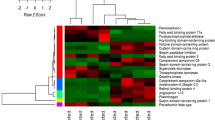Abstract
The presence and survival of pathogens inside the gut of leeches were studied by means of light and electron microscopy. In African leeches from Cameroon, blood was serologically positive for human immunodeficiency virus (HIV) and hepatitis B; blood ofHirudo medicinalis bought in German pharmacies contained up to 11 different species of bacteria. In experiments done at low (3°C) and high (22°, 32°C) temperatures, it was shown that ingested red and white blood cells survive for long periods. The time was prolonged to at least 6 months in cases in which the leeches were stored at 3°C. The same effect occurred with pathogens. Bacteriophages (viruses of bacteria) and bacteria persisted in large numbers for at least 6 months in the gut of experimentally infected leeches. Protozoan parasites such asToxoplasma gondii, Trypanosoma brucei brucei, orPlasmodium berghei were even capable of reproducting inside the gut of the leech. In the case ofPlasmodium parasites, this proceeded at low (3°C) and high (22°C) temperatures until all erythrocytes were used up. these parasites survived as long as the erythrocytes and lymphocytes were of good shape, i.e., around 5–6 weeks p.i. Single stages survived longer, especially at low temperatures. However, electron microscopy studies gave no hint of penetration of such pathogens into the unicellular salivary glands, which would initiate a direct transmission. Such transmission, however, is possible-many fish leeches directly transmit several blood parasites —when the leeches are squeezed during skin attachment or when they are manipulated by dropping salt solution on their backs while they are sucking. Consequently, the leech is a potential vector of many pathogens, especially in regions with an endemic spread of human and/or animal pathogens.
Similar content being viewed by others
References
Adams SL (1988) The medical leech. A page from the annelids of internal medicine. Ann Intern Med 109:399–405
Dickinson MH, Leut CM (1984) Feeding behavior of the medical leech,Hirudo medicinalis, L. J Comp Physiol [A] 154:449–455
Fortkamp E, Rieger M, Heisterberg-Montses G, Schweitzer S, Sommer R (1986) Cloning and expression inEscherichia coli of a synthetic DNA for Hirudin, the blood coagulation inhibitor in the leech. DNA 5:511–518
Kaestner A (1982) Lehrbuch der Speziellen Zoologie, Band I. In: Gruner HE (ed) Wirbellose Tiere, Teil 3. Vierte, völlig neu bearbeitete Auflage. Gustav Fischer, Stuttgart, pp 621
Kaiping B (1983) Untersuchungen über die Physiologie der Verdauung bei Hirudineen. Diplomarbeit, Universität Münster
Keim A (1993) Studies on the host specificity of the medical blood leechHirudo medicinalis. Parasitol Res 79:251–255
Koch MG (1987) AIDS — Vom Molekül zur Pandemie. Spektrum Wiss pp
Lent CM, Fliegner KH, Freedman E, Dickinson MH (1988) Ingestive behaviour and physiology of the medical leech. J Exp Biol 137:513–527
Mann KH (1962) Leeches (Hirudinea). Their structure, physiology, ecology and embryology. Pergamon Press, London
Markwardt F (1955) Untersuchungen über Hirudin. Naturwissenschaften 19:537–538
Mehlhorn H (1988) Parasitology in focus. Springer, Berlin Heidelberg New York
Mehlhorn H, Ruthmann A (1992) Allgemeine Protozoologie. Gustav Fischer, Jena Stuttgart
Minkin BI (1990) Leeches in modern medicine. Carol Tips 53:5–7
Puytorac P de, Grain J, Mignot JP (1987) Précis de Protistologie, Editions Boubée, Paris
Roters FJ, Zebe E (1992a) Protease inhibitors in the alimentary tract of the medical leechHirudo medicinalis: in vivo and in vitro studies. J Comp Physiol [B] 162:85–92
Roters FJ, Zebe E (1992b) Proteinases of the medical leech,Hirudo medicinalis: purification and partial characterisation of three enzymes from the digestive tract. Comp Biochem Physiol [B] 102:627–634
Shope RE (1957) The leech as a potential virus reservoir. J Exp Med 105:373–382
Snower DP, Ruef C, Kuritza AP, Edberg SC (1989)Aeromonas hydrophila infection associated with the use of medicinal leeches. J Clin Microbiol 27:1421–1422
Starke K (1989) The beginnings of hirudin. Trends Pharmacol Sci 10:99–110
Whitlock MR, O'Hare PM, Sanders R, Morrow NC (1983) The medical leech and its use in plastic surgery: a possible cause of infection. Br J Plastic Surg 36:342–346
Zebe E, Roters FJ, Kaiping B (1986) Metabolic changes in the medical leechHirudo medicinalis following feeding. Comp Biochem Physiol [A] 84:49–55
Author information
Authors and Affiliations
Rights and permissions
About this article
Cite this article
Nehili, M., Ilk, C., Mehlhorn, H. et al. Experiments on the possible role of leeches as vectors of animal and human pathogens: a light and electron microscopy study. Parasitol Res 80, 277–290 (1994). https://doi.org/10.1007/BF02351867
Received:
Accepted:
Issue Date:
DOI: https://doi.org/10.1007/BF02351867




